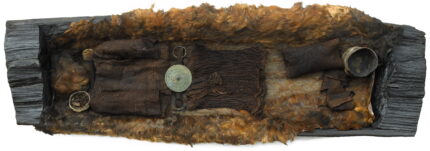The Bronze Age grave was discovered in 1921 near the village of Egtved on southeastern Denmark’s Jutland peninsula when a farmer who was digging up her burial mound struck her coffin with his shovel. She had been buried in a hollowed out oak trunk which was dendrochronologically dated to 1,370 B.C. The trunk was lined with cowhide and furnished with grave goods including a birch bucket at her feet. She was wearing a wool tunic under a cord skirt and a belt with a large circular bronze buckle.
The tree trunk coffin, delicate woolen clothing and the hairs of the cow hide were beautifully preserved, but there was little left of Egtved Girl herself, only her blonde hair, some teeth, nails and traces of skin and brain matter. She also left behind the imprint of her body on the cowhide. One molar was sufficient for researchers to determine via strontium isotope analysis that she was not born and raised in Denmark. She was likely from the Black Forest area of southern Germany and only lived in Denmark for a year or so before her death.
From the remains and body impression, researchers were able to determine she was between 16 and 18 years old when she died. She had shoulder-length hair with a whorl on the back of her head and was between 5’3″ and 5’5″ tall. With the information discovered from her burial and a large portion of educated guesswork, National Museum researchers worked with 3D artists to create a virtual avatar of Egtved Girl.
This isn’t a facial reconstruction derived from a skull. There is no skull. Her skin shade, facial features and eye color are guesses. The purpose is to create an engaging representation of Egtved Girl to introduce the exhibition to museum visitors.
Together with developers, 3D artists from Khora and the program Metahuman, the National Museum’s researchers have revived her as a digital human with a voice and living facial expressions. Her face is built with the help of the latest technology, which is usually used in computer games like Fortnite and The Witcher and in movies like Dune, Star Wars and The Mandalorian.
That technology has not previously been used in a museum. But it helps bring the past to life for a wide audience.
“Egtved Girl is important for our cultural heritage, and therefore it is crucial that we constantly increase the dissemination of her. Many visitors pass by her coffin and are in doubt as to whether she is actually lying there because the bones are gone. But now she draws attention to herself. At the same time, our desire is to create a stronger connection to the past, and this is best achieved if you can identify with a person from the past. Now you can come face to face with Egtved Girl”, says exhibition editor Mette Boritz.
It might be a bit of an unsettling encounter for unwitting visitors. But don’t take my word for it. Hear it from Egtved Girl herself:
